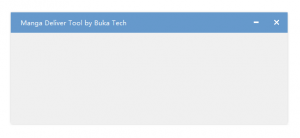..
让Qt的无边框窗口支持拖拽、Aero Snap、窗口阴影等特性
环境:Desktop Qt 5.4.1 MSVC2013 32bit
需要的库:dwmapi.lib 、user32.lib
需要头文件:<dwmapi.h> 、<windowsx.h>
在要处理的QWidget 构造函数中,添加以下两行:
setWindowFlags(Qt::Window | Qt::FramelessWindowHint);
SetWidgetBorderless(this);
SetWidgetBorderless的实现如下:
void SetWidgetBorderless(const QWidget *widget)
{
#ifdef Q_OS_WIN
HWND hwnd = reinterpret_cast<HWND>(widget->winId());
const LONG style = ( WS_POPUP | WS_CAPTION | WS_SYSMENU | WS_MINIMIZEBOX | WS_MAXIMIZEBOX | WS_THICKFRAME | WS_CLIPCHILDREN );
SetWindowLongPtr(hwnd, GWL_STYLE, style);
const MARGINS shadow = {1, 1, 1, 1};
DwmExtendFrameIntoClientArea(hwnd, &shadow);
SetWindowPos(hwnd, 0, 0, 0, 0, 0, SWP_FRAMECHANGED | SWP_NOMOVE | SWP_NOSIZE);
#endif
}
这个函数的作用是给无边框窗口加上阴影、Aero Snap以及其他动画特效。
这时窗口还无法手动更改大小,需要更改的话,需要自己实现一个QAbstractNativeEventFilter 类,内容如下:
class NativeEventFilter : public QAbstractNativeEventFilter
{
public:
bool nativeEventFilter(const QByteArray &eventType, void *message, long *result) Q_DECL_OVERRIDE
{
#ifdef Q_OS_WIN
if (eventType != "windows_generic_MSG")
return false;
MSG* msg = static_cast<MSG*>(message);
QWidget* widget = QWidget::find(reinterpret_cast<WId>(msg->hwnd));
if (!widget)
return false;
switch (msg->message) {
case WM_NCCALCSIZE: {
*result = 0;
return true;
}
case WM_NCHITTEST: {
const LONG borderWidth = 9;
RECT winrect;
GetWindowRect(msg->hwnd, &winrect);
long x = GET_X_LPARAM(msg->lParam);
long y = GET_Y_LPARAM(msg->lParam);
// bottom left
if (x >= winrect.left && x < winrect.left + borderWidth &&
y < winrect.bottom && y >= winrect.bottom - borderWidth)
{
*result = HTBOTTOMLEFT;
return true;
}
// bottom right
if (x < winrect.right && x >= winrect.right - borderWidth &&
y < winrect.bottom && y >= winrect.bottom - borderWidth)
{
*result = HTBOTTOMRIGHT;
return true;
}
// top left
if (x >= winrect.left && x < winrect.left + borderWidth &&
y >= winrect.top && y < winrect.top + borderWidth)
{
*result = HTTOPLEFT;
return true;
}
// top right
if (x < winrect.right && x >= winrect.right - borderWidth &&
y >= winrect.top && y < winrect.top + borderWidth)
{
*result = HTTOPRIGHT;
return true;
}
// left
if (x >= winrect.left && x < winrect.left + borderWidth)
{
*result = HTLEFT;
return true;
}
// right
if (x < winrect.right && x >= winrect.right - borderWidth)
{
*result = HTRIGHT;
return true;
}
// bottom
if (y < winrect.bottom && y >= winrect.bottom - borderWidth)
{
*result = HTBOTTOM;
return true;
}
// top
if (y >= winrect.top && y < winrect.top + borderWidth)
{
*result = HTTOP;
return true;
}
return false;
}
default:
break;
}
return false;
#else
return false;
#endif
}
};
然后在窗口创建之前,使用QApplication::installNativeEventFilter 方法把监听器注册给主程序。
要手动移动窗口位置的话,还要重截QWidget::mousePressEvent 方法:
void MyWidget::mousePressEvent(QMouseEvent *ev)
{
QWidget::mousePressEvent(ev);
if (!ev->isAccepted()) {
#ifdef Q_OS_WIN
ReleaseCapture();
SendMessage(reinterpret_cast<HWND>(winId()), WM_SYSCOMMAND, SC_MOVE + HTCAPTION, 0);
}
#endif
}
在实际操作时,有时还需要添加最大化和关闭按扭,这时正常调用QWidget::showMaximized()和QWidget::close() 等Qt自带方法即可。
最终实现效果大概是这样:
缩放动画、阴影什么的和Windows本地窗口一样。
